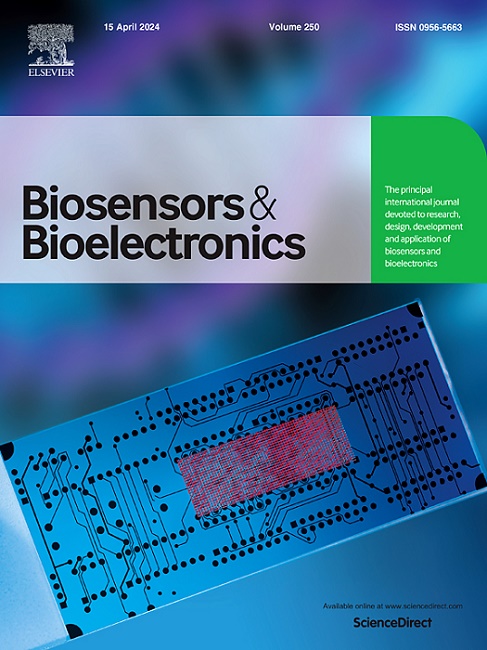Potential-resolved electrochemiluminescent immunoassay based on dual co-reactants regulation
IF 10.5
1区 生物学
Q1 BIOPHYSICS
引用次数: 0
Abstract
Multi-signal-based self-calibrating biosensors have become a research focus due to their superior accuracy and sensitivity in recent years. Herein, the potential-resolved differential ECL immunoassay based on dual co-reactants regulation was developed. Meso-tetra(4-carboxyphenyl)porphyrin (TCPP) functionalized zirconium dioxide (ZrO2) composites (TCPP-ZrO2) was first synthesized using TCPP as the luminophore and ZrO2 as the enhancer and stabilizer. The organic-inorganic hybrid structure of TCPP-ZrO2 limits the intramolecular motion of TCPP and accelerates the production of reactive radicals of co-reactants, thus exhibiting excellent ECL intensity and stability. Then, the potential-resolved ECL properties of TCPP-ZrO2 regulated only by two co-reactants were explored. On this basis, a differential ECL immunosensor was constructed for the sensitive and accurate determination of heart-fatty acid binding protein (hFABP) using 2-(dibutylamino)ethanol modified gold nanoparticles (DBAE@Au) as labels (ECL-1, +1.3 V) and ECL-2 (−1.3 V) triggered by potassium persulfate (K2S2O8) as the internal reference. In the presence of hFABP, DBAE@Au was captured by the sensing interface to generate ECL-1 and consume K2S2O8, leading to a significant decrease of ECL-2. According to the intensity difference between ECL-2 and ECL-1, the detection of hFABP was achieved with a low detection limit and a wide linear range. The proposed differential ECL immunosensor has been applied in testing human serum samples with satisfactory results, demonstrating its promising applications for clinical diagnosis.
基于双助反应物调控的电位分辨电化学发光免疫分析。
基于多信号的自校准生物传感器因其卓越的准确性和灵敏度而成为近年来的研究热点。本文开发了基于双共反应物调控的电位分辨差分 ECL 免疫分析法。首先以中-四(4-羧基苯基)卟啉(TCPP)为发光体,以二氧化锆(ZrO2)为增强剂和稳定剂,合成了中-四(4-羧基苯基)卟啉(TCPP)功能化二氧化锆(ZrO2)复合材料(TCPP-ZrO2)。TCPP-ZrO2 的有机-无机杂化结构限制了 TCPP 的分子内运动,加速了共反应物活性自由基的产生,从而表现出优异的 ECL 强度和稳定性。随后,研究人员探索了 TCPP-ZrO2 仅受两种共反应物调节的电位分辨 ECL 特性。在此基础上,利用 2-(二丁基氨基)乙醇修饰的纳米金颗粒(DBAE@Au)作为标签(ECL-1,+1.3 V)和以过硫酸钾(K2S2O8)为内参引发的 ECL-2(-1.3 V),构建了一种差分 ECL 免疫传感器,用于灵敏准确地测定心脏脂肪酸结合蛋白(hFABP)。在有 hFABP 存在的情况下,DBAE@Au 被传感界面捕获,产生 ECL-1,消耗 K2S2O8,导致 ECL-2 明显降低。根据 ECL-2 和 ECL-1 的强度差,hFABP 的检测具有较低的检测限和较宽的线性范围。所提出的差分 ECL 免疫传感器已被应用于人体血清样本的检测,并取得了令人满意的结果,表明其在临床诊断中具有广阔的应用前景。
本文章由计算机程序翻译,如有差异,请以英文原文为准。
求助全文
约1分钟内获得全文
求助全文
来源期刊

Biosensors and Bioelectronics
工程技术-电化学
CiteScore
20.80
自引率
7.10%
发文量
1006
审稿时长
29 days
期刊介绍:
Biosensors & Bioelectronics, along with its open access companion journal Biosensors & Bioelectronics: X, is the leading international publication in the field of biosensors and bioelectronics. It covers research, design, development, and application of biosensors, which are analytical devices incorporating biological materials with physicochemical transducers. These devices, including sensors, DNA chips, electronic noses, and lab-on-a-chip, produce digital signals proportional to specific analytes. Examples include immunosensors and enzyme-based biosensors, applied in various fields such as medicine, environmental monitoring, and food industry. The journal also focuses on molecular and supramolecular structures for enhancing device performance.
 求助内容:
求助内容: 应助结果提醒方式:
应助结果提醒方式:


